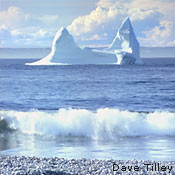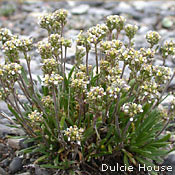The limestone barrens in the Sandy Cove Ecological Reserve support a species of plant found nowhere else in the world. Long’s Braya (Braya longii) is a small plant that grows only on a 10 km stretch near the community of Sandy Cove.
- How to get There
- Activities
- Maps
- Services
- Fees and Schedules
- Rules and Regulations
- Permits
- Other Resources
- Contact Information
Located along the Great Northern Peninsula, the reserve protects two small parcels of land. Collectively these two parcels protect 15 hectares of limestone barrens along the Strait of Belle Isle.
The coastal barrens, harsh local climate and strong winds create conditions that foster an unlikely variety of arctic-alpine plants. Arctic-alpine plants are those plants that live at high altitudes and are adapted to dry conditions with rocky, shallow soils. The flowers are often brightly coloured and self-pollinated with long, properly anchored roots. Purple Saxifrage, Moss Campion, Mountain Avens and Butterwort can be found alongside Long’s Braya on the coastal barrens.
Sandy Cove Ecological Reserve lies within the Strait of Belle Isle Barrens ecoregion (762 KB). The flat coastal areas typical of the ecoregion have a thin vegetation cover that includes dispersed mats of crowberry over calcareous gravel and bedrock. There are few trees or tall shrubs.
At first sight, the limestone barrens appear desolate, yet a closer look reveals tiny arctic plants that grow in the rock and soil. These plant species are able to withstand and even thrive in this particular climate and limestone geology. The frost action prevents other plants from growing in the area, however it enables rare plants such as Long’s Braya to grow with limited competition.
Long’s Braya is a member of the mustard family and is a self-pollinating plant that relies heavily on wind for dispersal. It dies back in the winter, regrows each spring and can live for several years. It is also one of the rarest plants in the world. It has been designated by COSEWIC as endangered since 1997 and as of 2000, there were an estimated 7000 plants in existence.
Because of the reserve’s unique flora, it is often the scene of intensive research. In fact, the reserve was created to provide protection for the plants and for scientific research and educational touring purposes.
Sandy Cove Ecological Reserve was designated as a provisional ecological reserve in April 2007 received full ecological reserve status in March 2013.
Please do not travel in the reserve for any reason when soil conditions are wet, such as following snow melt or after periods of heavy rainfall. Travel on the fine-particled soils of the limestone barrens during wet conditions can cause irreparable soil compaction and damage to critical Braya habitat.
How to get there
From Deer Lake and the Trans-Canada Highway, the community of Sandy Cove is about 320 km up Newfoundland’s Northern Peninsula on Route 430. St. Anthony is about 100 km further along.
Off-road vehicles, including ATVs and snowmobiles, are prohibited in the reserve.
Activities

Scientific research is the main activity that takes place in the reserve. For more information and research guidelines, see Science and Research.
Off-road vehicles, including ATVs and snowmobiles, are not allowed in the reserve.
Hunting is not permitted in the reserve.
Camping and building a fire is prohibited in the reserve.
Services
There are no services in the reserve.
Fees and Schedule
There are no fees involved in obtaining scientific research, commercial operator or educational tour permits.
Rules and Regulations
Biodiversity protection and habitat conservation are two of the key purposes of ecological reserves, so certain rules apply within all the reserves in the province.
The public can visit most ecological reserves for educational purposes or low-impact recreational activities, such as hiking or sightseeing. This is true at Sandy Cove, although because of the rare plants’ vulnerability, visitors are asked to be careful and watch their step.
The following activities are strictly prohibited in all wilderness and ecological reserves:
- Disturbing, destroying, or removing plants, animals, or fossils
- Introducing plants, animals, or anything else to the reserve landscape
- Forestry, mining (including exploration), hydro development, agriculture, new roads, tracks, or building construction
- Driving off-road vehicles including all-terrain vehicles (ATVs)

At the Sandy Cove Ecological Reserve:
- No entry permit is required, though visitors are asked to avoid walking on the tiny arctic-alpine plants while in the reserve
- Because of the vulnerability of the plants, camping and building fires are not permitted in the reserve
- Taking seeds and plant cuttings is also prohibited
Read the official Sandy Cove Ecological Reserve Management Plan and reserve regulations:
- Sandy Cove Ecological Reserve Management Plan(2.2 MB)
- Botanical Ecological Reserve Regulations
- Sandy Cove Ecological Reserve Order
- Wilderness and Ecological Reserves Act
Adobe® Acrobat® Reader software can be used for viewing PDF documents. Download Acrobat® Reader for free
